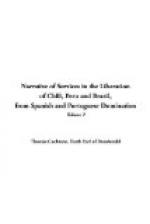This party having taken up its position, the main body moved forward, cheering and firing in the air, to intimate to the Spaniards that their chief reliance was on the bayonet. The enemy, meanwhile, kept up an incessant fire of artillery and musketry in the direction of the shouts, but without effect, as no aim could be taken in the dark. Whilst the patriots were thus noisily advancing, a gallant young officer, Ensign Vidal—who had previously distinguished himself at Santa—got under the inland flank of the fort, and with a few men, contrived unperceived to tear up some pallisades, by which a bridge was made across the ditch, whereby he and his small party entered, and formed noiselessly under cover of some branches of trees which overhung it, the garrison directing their whole attention to the shouting patriots in an opposite direction.
A volley from Vidal’s party convinced the Spaniards that they had been taken in flank. Without waiting to ascertain the number of those who had outflanked them, they instantly took to flight, filling with a like panic a column of three hundred men, drawn up behind the fort. The Chilians, who were now well up, bayoneted them by dozens, in their efforts to gain the other forts, which were opened to receive them; the patriots thus entering at the same time, and driving them from fort to fort into the Castle of Corral, together with two hundred more, who had abandoned some guns advantageously placed on a height at Fort Chorocomayo. The Corral was stormed with equal rapidity, a number of the enemy escaping in boats to Valdivia, others plunging into the forest; whilst upwards of a hundred, besides officers, fell into our hands, the like number being found bayoneted on the following morning. Our loss was seven men killed, and nineteen wounded.
The Spaniards had, no doubt, regarded their position as impregnable, which, considering its difficulty of access and almost natural impenetrability, it ought to have been, if properly defended. They had only found out their error when too late, thus justifying my former remark to the military officers, that an attack where least expected is almost invariably crowned with success. Much less had the Spaniards calculated on a night attack, the most favourable of all to the attacking party, as necessitating unity of action—and the least favourable of all to the party attacked, as inspiring doubt and panic, almost certain to end in irresolution and defeat. The garrison consisted of the Cantabria regiment of the line, numbering about eight hundred, with whom was associated a militia of upwards of a thousand.
On the 5th, the Intrepido and Montezuma, which had been left at the Aguada Inglesa, entered the harbour, being fired at in their passage by Fort Niebla on the eastern shore. On their coming to an anchor at the Corral, two hundred men were again embarked to attack Forts Niebla, Carbonero, and Piojo. The O’Higgins now appearing in sight off the mouth of the harbour, the Spaniards abandoned the forts on the eastern side, no doubt judging that as the western forts had been captured without the aid of the frigate, they had—now that she had arrived—no chance of successfully defending them; the patriot troops were therefore disembarked at Fort Niebla till the tide served to take them to the town of Valdivia.




